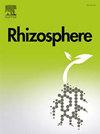Stimulating effect of increasing N fertilization on plant growth and rhizosphere microbial activity at low levels of N2O emissions
IF 3.4
3区 生物学
Q1 PLANT SCIENCES
引用次数: 0
Abstract
A greenhouse experiment was conducted to assess the short-term effects of nitrogen (N) addition on plant growth, rhizosphere microbial activity, and N2O emissions. Nitrogen was applied to lettuce plants once the roots had occupied the entire volume of the pots, ensuring that the whole soil volume could be considered rhizosphere soil. The hypothesis tested was that adding a low amount of plant-available nitrogen to the rhizosphere would increase plant root growth and root-associated microbial activity with minimal N2O emissions. Conversely, when the nitrogen availability exceeds the demands of the plant-soil system, it decreases root and microbial growth while increasing N2O emissions. Results indicated that nitrogen applied at rates of 0–100 mg N kg−1 was efficiently utilized by plants, supporting the growth of both aboveground and belowground plant biomass and microbial biomass. Notably, the addition of nitrogen did not increase N2O production. These findings suggest that dense root systems can efficiently utilize relatively high amounts of nitrogen.
求助全文
约1分钟内获得全文
求助全文
来源期刊

Rhizosphere
Agricultural and Biological Sciences-Agronomy and Crop Science
CiteScore
5.70
自引率
8.10%
发文量
155
审稿时长
29 days
期刊介绍:
Rhizosphere aims to advance the frontier of our understanding of plant-soil interactions. Rhizosphere is a multidisciplinary journal that publishes research on the interactions between plant roots, soil organisms, nutrients, and water. Except carbon fixation by photosynthesis, plants obtain all other elements primarily from soil through roots.
We are beginning to understand how communications at the rhizosphere, with soil organisms and other plant species, affect root exudates and nutrient uptake. This rapidly evolving subject utilizes molecular biology and genomic tools, food web or community structure manipulations, high performance liquid chromatography, isotopic analysis, diverse spectroscopic analytics, tomography and other microscopy, complex statistical and modeling tools.
 求助内容:
求助内容: 应助结果提醒方式:
应助结果提醒方式:


